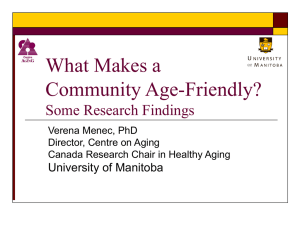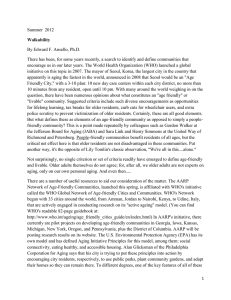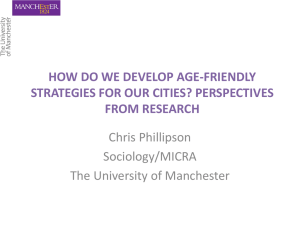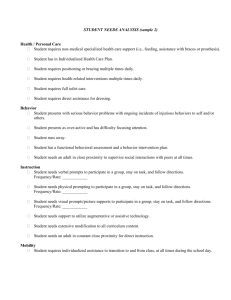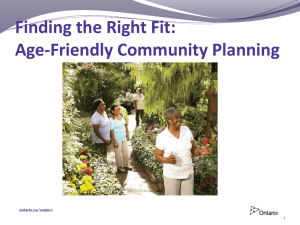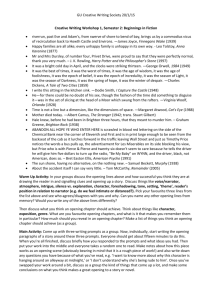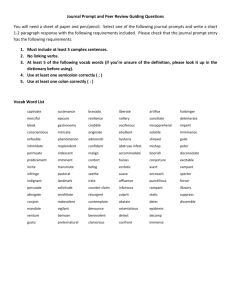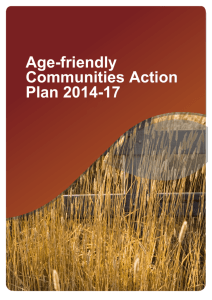Conducting a Focus Group Community Assessment
advertisement
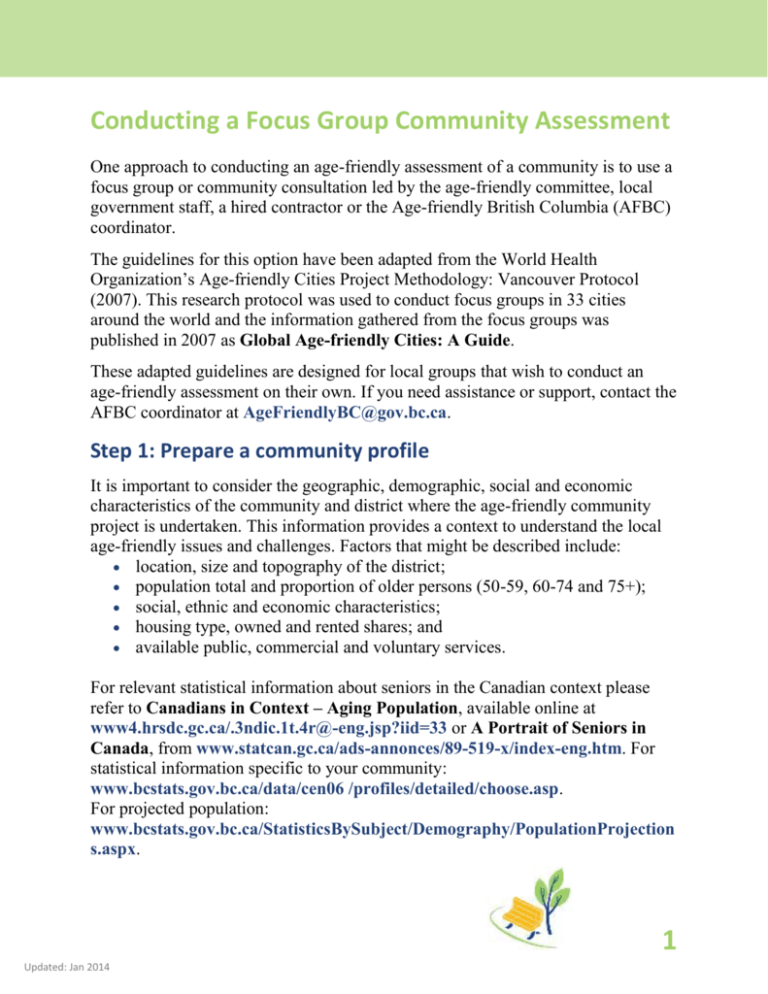
Conducting a Focus Group Community Assessment One approach to conducting an age-friendly assessment of a community is to use a focus group or community consultation led by the age-friendly committee, local government staff, a hired contractor or the Age-friendly British Columbia (AFBC) coordinator. The guidelines for this option have been adapted from the World Health Organization’s Age-friendly Cities Project Methodology: Vancouver Protocol (2007). This research protocol was used to conduct focus groups in 33 cities around the world and the information gathered from the focus groups was published in 2007 as Global Age-friendly Cities: A Guide. These adapted guidelines are designed for local groups that wish to conduct an age-friendly assessment on their own. If you need assistance or support, contact the AFBC coordinator at AgeFriendlyBC@gov.bc.ca. Step 1: Prepare a community profile It is important to consider the geographic, demographic, social and economic characteristics of the community and district where the age-friendly community project is undertaken. This information provides a context to understand the local age-friendly issues and challenges. Factors that might be described include: location, size and topography of the district; population total and proportion of older persons (50-59, 60-74 and 75+); social, ethnic and economic characteristics; housing type, owned and rented shares; and available public, commercial and voluntary services. For relevant statistical information about seniors in the Canadian context please refer to Canadians in Context – Aging Population, available online at www4.hrsdc.gc.ca/.3ndic.1t.4r@-eng.jsp?iid=33 or A Portrait of Seniors in Canada, from www.statcan.gc.ca/ads-annonces/89-519-x/index-eng.htm. For statistical information specific to your community: www.bcstats.gov.bc.ca/data/cen06 /profiles/detailed/choose.asp. For projected population: www.bcstats.gov.bc.ca/StatisticsBySubject/Demography/PopulationProjection s.aspx. 1 Updated: Jan 2014 Step 2: Organize Focus Group(s) A focus group can provide descriptive information about the age-friendly conditions and issues in your community and can help identify priorities for action. The following points will help you organize focus group research to get the information you need. Recruit focus group participants Consider conducting several focus groups. Each group should have about eight participants who represent a variety of stakeholders, ability levels and cultural groups. Include seniors from varying age groups (e.g., 50-64, 65-75, 75 and over) and, if possible, include informal caregivers of older persons to provide information on the challenges caregivers face. The focus group leader guides the discussion, and encourages all participants to contribute. The leader should have focus group experience and an understanding of seniors’ issues. Manage the group sessions Choose a location that is central and accessible, in a room that can comfortably fit the group, with tables, chairs and materials (for example flip charts, projectors, refreshments). Allow two to three hours, including a break, or consider holding two sessions on separate days. Provide the community profile, a list of focus group topics and questions to participants in advance so they can think about them. Use the sample discussion guide attached. It is helpful to have audio recorders, a flip chart or white board to record and illustrate ideas and themes that arise, name tags and refreshments. Make sure you meet the requirements of the Freedom of Information and Protection of Privacy Act, have the consent of participants to record the discussion, and inform them about how the information will be used. This can be developed in consultation with your community legal advisor. You may want to gather basic information about participants (for example, age and area where they live) to make sure the whole community is represented, but the information must be kept confidential. Consider arranging transportation to the location. 2 Make sure the leader has reference material and contact information available if participants want to follow up on an issue. Sample introduction: An age-friendly community is a community which enables older persons to live in security, enjoy good health and participate fully in society. We are going to talk about many different aspects of the community, including the environment, buildings, roads, and the different services and activities in the community. From your experience as (choose one of the following: an older person, a person providing care to an older person, or, a provider of services in the community) I would like to hear about the positive experiences, or good features of ___________________________ (name of community), that show the ways in which our community is now age-friendly. I also want to learn about the ways in which our community is NOT age-friendly. Finally, I would like your suggestions on ways to improve age-friendliness. There are no right or wrong answers. Every person's opinion is important. The session is being tape-recorded so that we don’t miss anything you say. Be assured that you will not be personally identified in the final report. So that we can understand the tape, it is important that only one person speaks at a time. I will make sure that everyone gets a chance to have their say. Adapted from WHO’s Age-friendly Cities Project Methodology: Vancouver Protocol, 2007 3 Focus group tips Describe age-friendly communities and issues in your welcome introduction to the group. Let the discussion develop and explore issues as they arise, rather than following a fixed agenda. Allow 10-15 minutes per question or issue. If a topic does not bring out much discussion despite a few prompting questions, move on to the next topic – another group of participants may have more to say in that area. Step 3: Summarize and report on the results You will want to summarize the discussion results and report on: aspects of the community that are age-friendly (advantages); barriers and problems that show how the community is not age-friendly (barriers); suggestions to improve the problems or barriers; and potential priorities for action. It is important to distinguish the group consensus from a few individual opinions (however strongly they may be expressed). You may want to look for differences in the results if separate focus groups representing different ages or stakeholder groups were consulted. The attached Results Summary Sheet will help. Share your summary with the participants and publicize it for comment. 4 Sample Focus Group Discussion Guide FOR ALL TOPICS – Remind participants you want to hear about positive experiences, negative experiences, and ideas for improvements. WARM-UP QUESTION What is it like to live in (name of the city/district/town) as an older person? Sample prompts: Good features? Problems? Topic 1: OUTDOOR SPACES AND BUILDINGS What is it like to step outside of your home to go for a walk to get fresh air, run errands or visit? Sample prompts: Design and maintenance of sidewalks and curbs? Street intersections and crosswalks? Traffic volume, noise? Particular times of day, like at night? Green spaces, walking areas? Street lighting? Protection from sun, rain or wind? Benches, rest areas? Sense of physical safety and security? What is it like to go into buildings, such as public offices or stores? Sample prompts: Stairs, doors, lift devices, corridors, floors, lighting, signage, toilets, rest areas? 5 Topic 2: TRANSPORTATION (If public transportation is available) Describe your experience using public or community transportation services in the community. Sample prompts: • Affordable? • Easy to get to? • Easy to board? • Adapted for disabled persons? • Frequent enough when you want to travel? • On time? • Extensive routes to go wherever one wants? • Waiting areas and stops with benches, lighting, protection from the elements? • Secure from crime? What is it like to get around in the community? Sample prompts: Legible street signs? Legible street numbers? Lighting at intersections? Easy to understand traffic signals? Sufficient and close parking? Handicapped reserved parking? Drop off and pick up areas? Driver refresher courses? 6 Topic 3: HOUSING Tell me about the house, apartment or seniors’ accommodation you live in. If your needs change, what are your choices for housing in the community? Sample prompts about acceptability: Cost? Comfort? Physically safe? Security from crime? Proximity to services? Sample prompts about mobility and independence in the home: Can you move about easily? Reach and store things easily? Do housework and chores? Do you have someone who can help you if needed? Topic 4: RESPECT AND SOCIAL INCLUSION In what ways does your community show, or not show, respect for you as an older person? In what ways does your community include, or not include, you as an older person in activities and events? Sample prompts: Politeness? Listening? Helpfulness? Consultation? Choices offered (for both disabled and non-disabled)? Public recognition of the contributions of older people? Responsiveness to needs in services and programs? Intergenerational activities? 7 Topic 5: SOCIAL PARTICIPATION How easily can you socialize in your community? Tell me about your participation in other activities, like education, culture, recreation, or spiritual activities? Sample prompts: Affordable? Accessible? Frequent? Convenient location? Convenient times? Offer choices? Interesting? Topic 6: COMMUNICATION AND INFORMATION What is your experience getting the information you need in your community, for example, about services or events? This can be information you get by telephone, radio, TV, in print, online or in person. Sample prompts: Accessible? Useful? Timely? Easy to understand? Difficulties with automated systems, print format and size? 8 Topic 7: CIVIC PARTICIPATION AND EMPLOYMENT Tell me about your participation in volunteer work. Tell me about your participation in paid work. Are you employed now, or are you looking for paid work? Tell me about your participation in public community affairs, like community associations or municipal councils. Sample prompts: Variety of opportunities? Accessible opportunities? Attractiveness? Availability of information about opportunities? Recognition provided? Paid work? Adjustment to older people’s abilities? Adjustment to older persons' preferences? Ways used to motivate older persons' participation? Topic 8: COMMUNITY SUPPORT AND HEALTH SERVICES What is your experience with the health and social services in the community? Sample prompts: Are they responsive to the needs of older people? Types of services available? Accessibility? Affordability? Responsiveness of services to individual needs? WRAP-UP QUESTION Before we finish, are there any other issues or areas we haven't discussed that you want to raise? 9 Sample Results Summary Sheet (Complete one summary sheet for each focus group) Topic Age-friendly advantages: What is working in our community… Age-friendly barriers: What is not working in our community… Suggestions for improvement… Outdoor Spaces and Buildings Transportation Housing Respect and Social Inclusion Social Participation Communication and Information Civic Participation and Employment Community Support and Health Services Issues raised in wrap-up question: ____________________________________________________ ____________________________________________________ ____________________________________________________ ____________________________________________________ ____________________________________________________ 10
